Abstract
Pro-phenol oxidase [pro-PO; zymogen of phenol oxidase (monophenol, L-dopa:oxygen oxidoreductase, EC 1.14.18.1)] is present in the hemolymph plasma of the silkworm Bombyx mori. Pro-PO is a heterodimeric protein synthesized by hemocytes. A specific serine proteinase activates both subunits through a limited proteolysis. The amino acid sequences of both subunits were deduced from their respective cDNAs; amino acid sequence homology between the subunits was 51%. The deduced amino acid sequences revealed domains highly homologous to the copper-binding site sequences (copper-binding sites A and B) of arthropod hemocyanins. The overall sequence homology between silkworm pro-PO and arthropod hemocyanins ranged from 29 to 39%. Phenol oxidases from prokaryotes, fungi, and vertebrates have sequences homologous to only the copper-binding site B of arthropod hemocyanins. Thus, silkworm pro-PO DNA described here appears distinctive and more closely related to arthropod hemocyanins. The pro-PO-activating serine proteinase was shown to hydrolyze peptide bonds at the carboxyl side of arginine in the sequence-Asn-49-Arg-50-Phe-51-Gly-52- of both subunits. Amino groups of N termini of both subunits were indicated to be N-acetylated. The cDNAs of both pro-PO subunits lacked signal peptide sequences. This result supports our contention that mature pro-PO accumulates in the cytoplasm of hemocytes and is released by cell rupture, as for arthropod hemocyanins.
Full text
PDF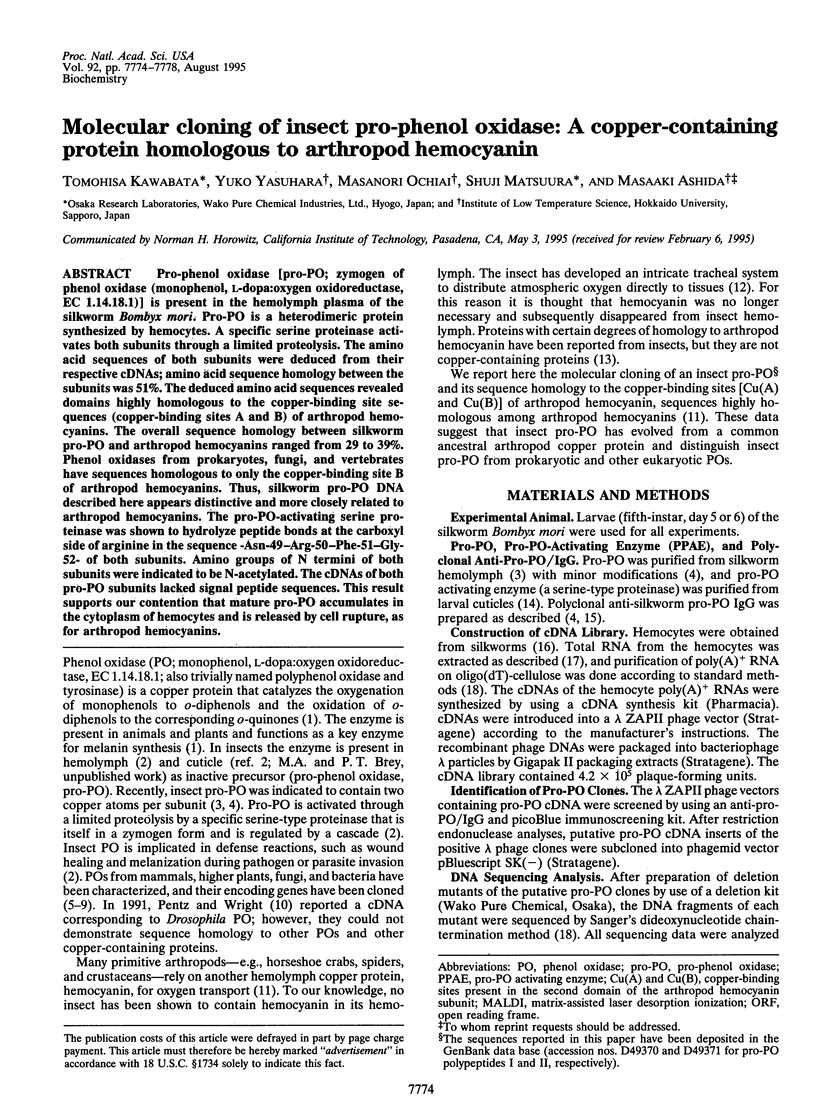
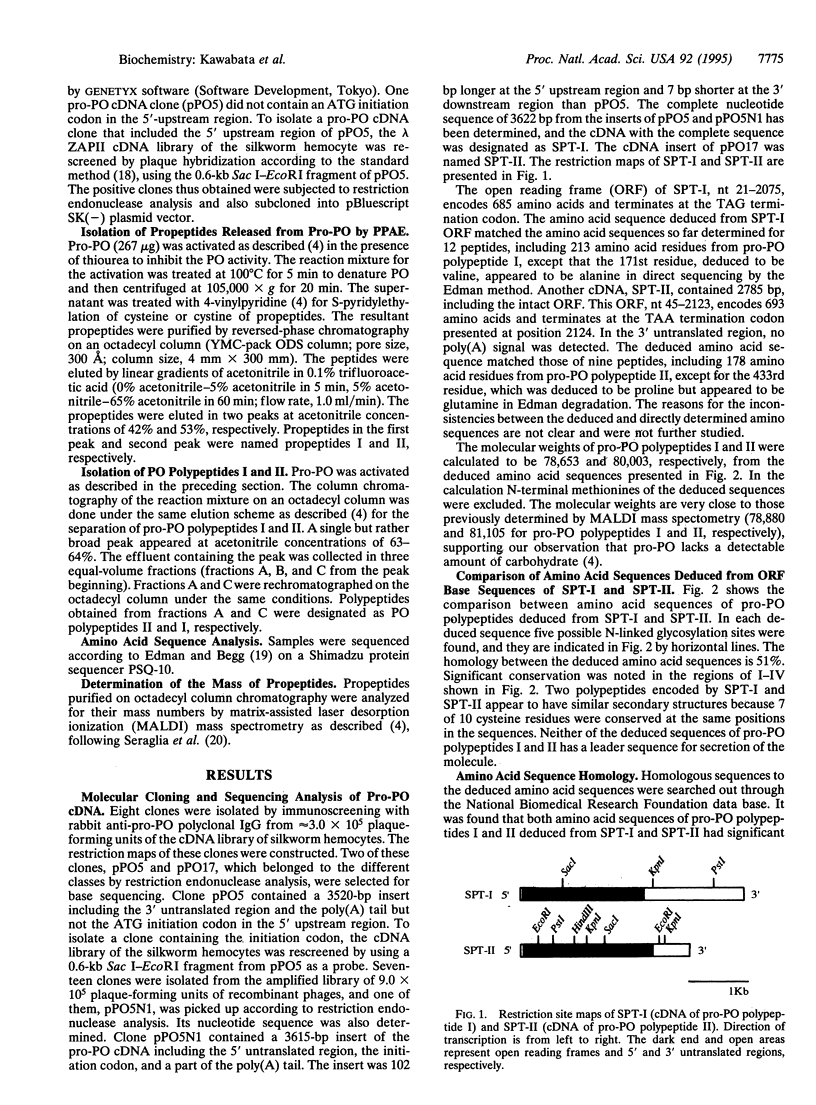
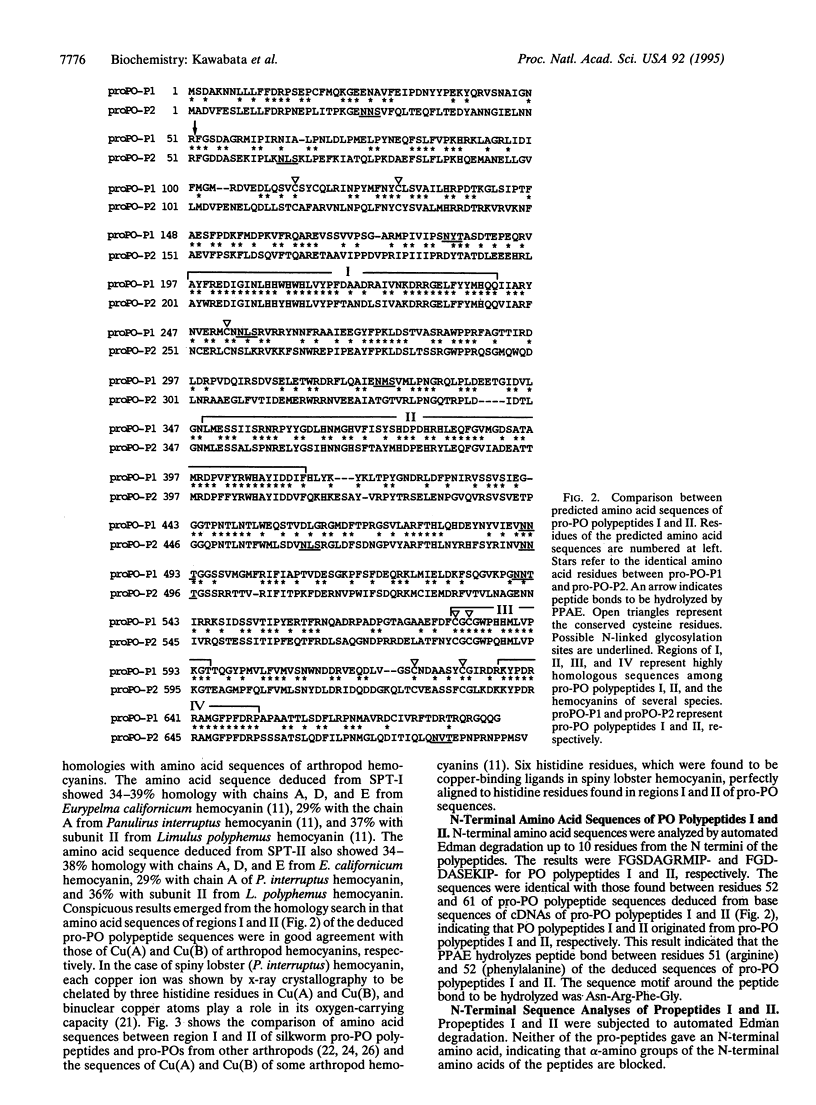
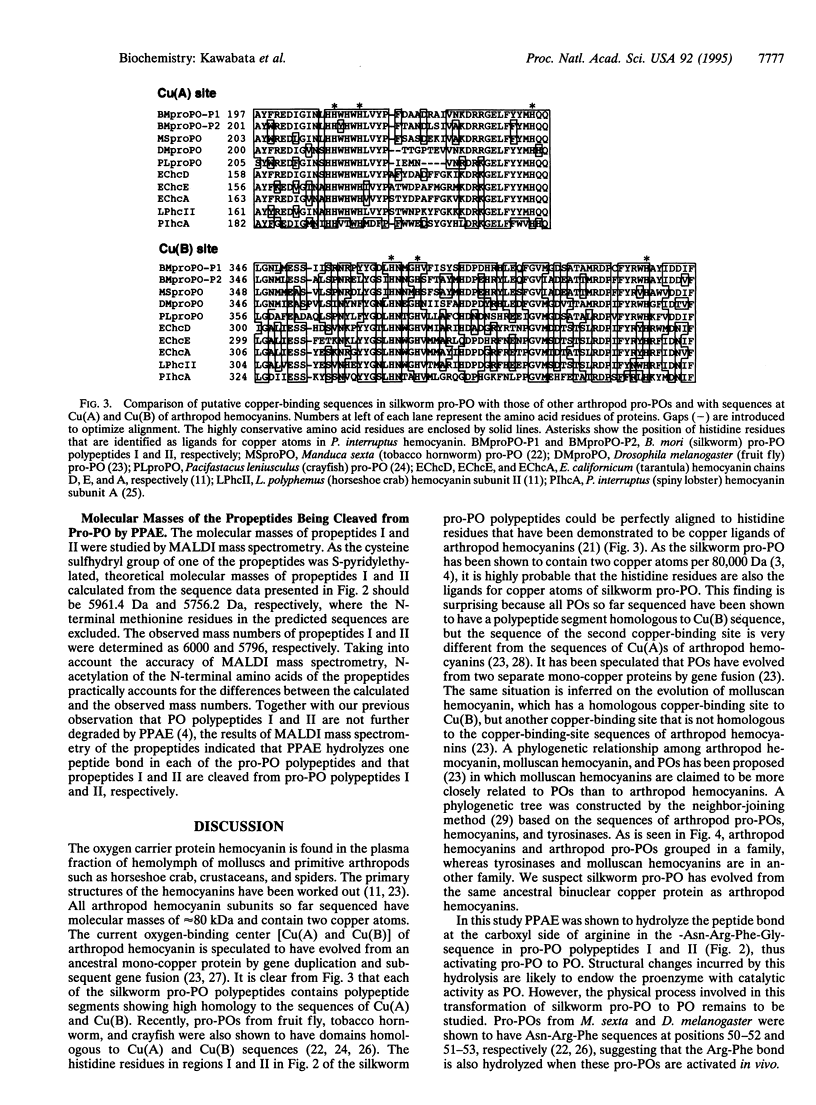
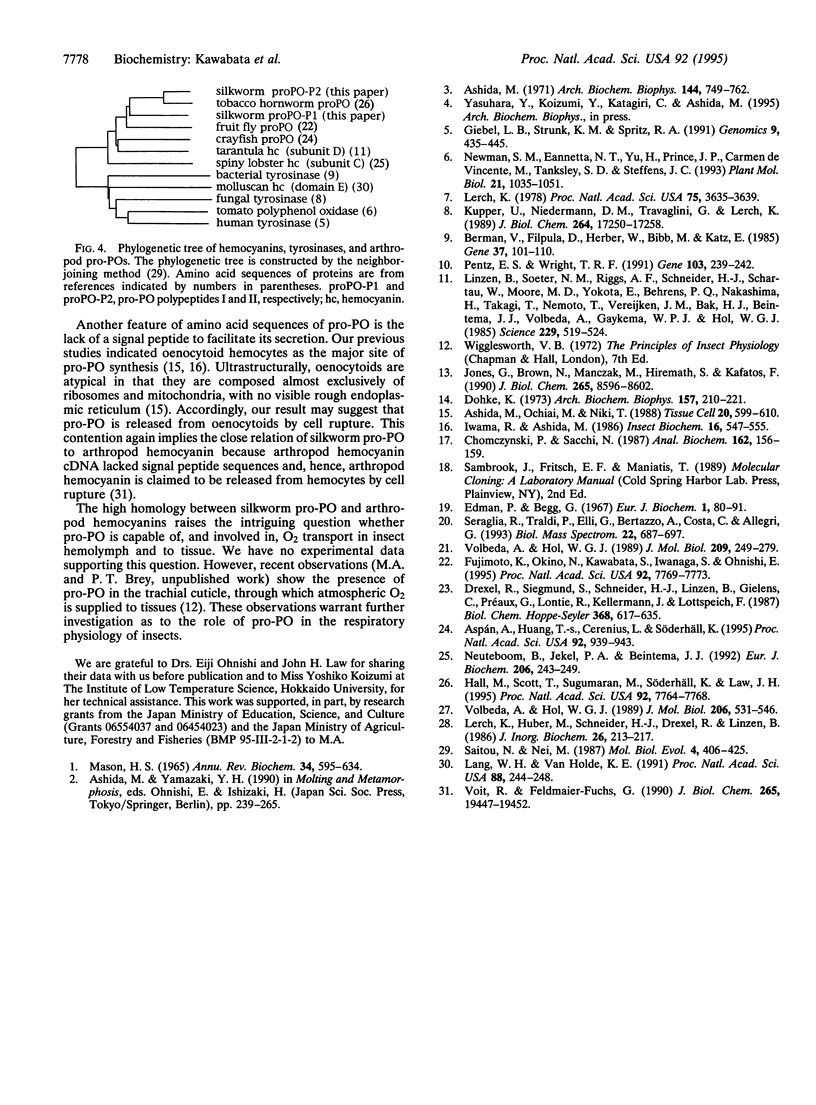
Selected References
These references are in PubMed. This may not be the complete list of references from this article.
- Ashida M. Purification and characterization of pre-phenoloxidase from hemolymph of the silkworm Bombyx mori. Arch Biochem Biophys. 1971 Jun;144(2):749–762. doi: 10.1016/0003-9861(71)90383-3. [DOI] [PubMed] [Google Scholar]
- Aspán A., Huang T. S., Cerenius L., Söderhäll K. cDNA cloning of prophenoloxidase from the freshwater crayfish Pacifastacus leniusculus and its activation. Proc Natl Acad Sci U S A. 1995 Feb 14;92(4):939–943. doi: 10.1073/pnas.92.4.939. [DOI] [PMC free article] [PubMed] [Google Scholar]
- Bernan V., Filpula D., Herber W., Bibb M., Katz E. The nucleotide sequence of the tyrosinase gene from Streptomyces antibioticus and characterization of the gene product. Gene. 1985;37(1-3):101–110. doi: 10.1016/0378-1119(85)90262-8. [DOI] [PubMed] [Google Scholar]
- Chomczynski P., Sacchi N. Single-step method of RNA isolation by acid guanidinium thiocyanate-phenol-chloroform extraction. Anal Biochem. 1987 Apr;162(1):156–159. doi: 10.1006/abio.1987.9999. [DOI] [PubMed] [Google Scholar]
- Dohke K. Studies on prephenoloxidase-activating enzyme from cuticle of the silkworm Bombyx mori. II. Purification and characterization of the enzyme. Arch Biochem Biophys. 1973 Jul;157(1):210–221. doi: 10.1016/0003-9861(73)90407-4. [DOI] [PubMed] [Google Scholar]
- Drexel R., Siegmund S., Schneider H. J., Linzen B., Gielens C., Préaux G., Lontie R., Kellermann J., Lottspeich F. Complete amino-acid sequence of a functional unit from a molluscan hemocyanin (Helix pomatia). Biol Chem Hoppe Seyler. 1987 Jun;368(6):617–635. doi: 10.1515/bchm3.1987.368.1.617. [DOI] [PubMed] [Google Scholar]
- Edman P., Begg G. A protein sequenator. Eur J Biochem. 1967 Mar;1(1):80–91. doi: 10.1007/978-3-662-25813-2_14. [DOI] [PubMed] [Google Scholar]
- Fujimoto K., Okino N., Kawabata S., Iwanaga S., Ohnishi E. Nucleotide sequence of the cDNA encoding the proenzyme of phenol oxidase A1 of Drosophila melanogaster. Proc Natl Acad Sci U S A. 1995 Aug 15;92(17):7769–7773. doi: 10.1073/pnas.92.17.7769. [DOI] [PMC free article] [PubMed] [Google Scholar]
- Giebel L. B., Strunk K. M., Spritz R. A. Organization and nucleotide sequences of the human tyrosinase gene and a truncated tyrosinase-related segment. Genomics. 1991 Mar;9(3):435–445. doi: 10.1016/0888-7543(91)90409-8. [DOI] [PubMed] [Google Scholar]
- Hall M., Scott T., Sugumaran M., Söderhäll K., Law J. H. Proenzyme of Manduca sexta phenol oxidase: purification, activation, substrate specificity of the active enzyme, and molecular cloning. Proc Natl Acad Sci U S A. 1995 Aug 15;92(17):7764–7768. doi: 10.1073/pnas.92.17.7764. [DOI] [PMC free article] [PubMed] [Google Scholar]
- Jones G., Brown N., Manczak M., Hiremath S., Kafatos F. C. Molecular cloning, regulation, and complete sequence of a hemocyanin-related, juvenile hormone-suppressible protein from insect hemolymph. J Biol Chem. 1990 May 25;265(15):8596–8602. [PubMed] [Google Scholar]
- Kupper U., Niedermann D. M., Travaglini G., Lerch K. Isolation and characterization of the tyrosinase gene from Neurospora crassa. J Biol Chem. 1989 Oct 15;264(29):17250–17258. [PubMed] [Google Scholar]
- Lang W. H., van Holde K. E. Cloning and sequencing of Octopus dofleini hemocyanin cDNA: derived sequences of functional units Ode and Odf. Proc Natl Acad Sci U S A. 1991 Jan 1;88(1):244–248. doi: 10.1073/pnas.88.1.244. [DOI] [PMC free article] [PubMed] [Google Scholar]
- Lerch K. Amino acid sequence of tyrosinase from Neurospora crassa. Proc Natl Acad Sci U S A. 1978 Aug;75(8):3635–3639. doi: 10.1073/pnas.75.8.3635. [DOI] [PMC free article] [PubMed] [Google Scholar]
- Linzen B., Soeter N. M., Riggs A. F., Schneider H. J., Schartau W., Moore M. D., Yokota E., Behrens P. Q., Nakashima H., Takagi T. The structure of arthropod hemocyanins. Science. 1985 Aug 9;229(4713):519–524. doi: 10.1126/science.4023698. [DOI] [PubMed] [Google Scholar]
- MASON H. S. OXIDASES. Annu Rev Biochem. 1965;34:595–634. doi: 10.1146/annurev.bi.34.070165.003115. [DOI] [PubMed] [Google Scholar]
- Neuteboom B., Jekel P. A., Beintema J. J. Primary structure of hemocyanin subunit c from Panulirus interruptus. Eur J Biochem. 1992 May 15;206(1):243–249. doi: 10.1111/j.1432-1033.1992.tb16922.x. [DOI] [PubMed] [Google Scholar]
- Newman S. M., Eannetta N. T., Yu H., Prince J. P., de Vicente M. C., Tanksley S. D., Steffens J. C. Organisation of the tomato polyphenol oxidase gene family. Plant Mol Biol. 1993 Mar;21(6):1035–1051. doi: 10.1007/BF00023601. [DOI] [PubMed] [Google Scholar]
- Pentz E. S., Wright T. R. Drosophila melanogaster diphenol oxidase A2: gene structure and homology with the mouse mast-cell tum- transplantation antigen, P91A. Gene. 1991 Jul 22;103(2):239–242. doi: 10.1016/0378-1119(91)90279-k. [DOI] [PubMed] [Google Scholar]
- Saitou N., Nei M. The neighbor-joining method: a new method for reconstructing phylogenetic trees. Mol Biol Evol. 1987 Jul;4(4):406–425. doi: 10.1093/oxfordjournals.molbev.a040454. [DOI] [PubMed] [Google Scholar]
- Seraglia R., Traldi P., Elli G., Bertazzo A., Costa C., Allegri G. Laser desorption ionization mass spectrometry in the study of natural and synthetic melanins. I--Tyrosine melanins. Biol Mass Spectrom. 1993 Dec;22(12):687–697. doi: 10.1002/bms.1200221204. [DOI] [PubMed] [Google Scholar]
- Voit R., Feldmaier-Fuchs G. Arthropod hemocyanins. Molecular cloning and sequencing of cDNAs encoding the tarantula hemocyanin subunits a and e. J Biol Chem. 1990 Nov 15;265(32):19447–19452. [PubMed] [Google Scholar]
- Volbeda A., Hol W. G. Crystal structure of hexameric haemocyanin from Panulirus interruptus refined at 3.2 A resolution. J Mol Biol. 1989 Sep 20;209(2):249–279. doi: 10.1016/0022-2836(89)90276-3. [DOI] [PubMed] [Google Scholar]
- Volbeda A., Hol W. G. Pseudo 2-fold symmetry in the copper-binding domain of arthropodan haemocyanins. Possible implications for the evolution of oxygen transport proteins. J Mol Biol. 1989 Apr 5;206(3):531–546. doi: 10.1016/0022-2836(89)90499-3. [DOI] [PubMed] [Google Scholar]


